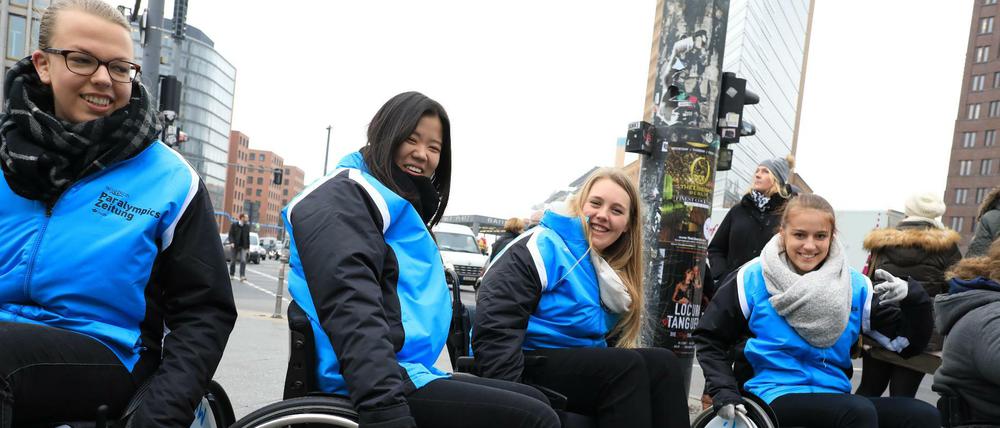
© Thilo Rückeis
Paralympics Project: Challenges using a wheelchair the first time
Is Berlin really barrier-free? Young journalists from the "Paralympics Zeitung" went on an accessibility tour - using wheelchairs and wearing blindfolds.
By the time we reached the Christmas market at Potsdamer Platz, I exchanged roles with my partner and hopped onto a wheelchair. Having been to the market the night before, I was confident about my ability to navigate through the market despite the huge crowd. After taking the advice from my fellow team mates that not wearing gloves makes it easier to roll the wheel, I took off mine and shivered at the feeling of cold metal wheel on a chilly day when the temperature averaged 0°C.
As soon as I was settled, I looked up and felt that something was different. It was the exact same market that I had visited less than 24 hours ago, and yet, it was very different. Instead of making eye contact with people like I did the day before, I was making eye contact with the food and souvenirs on the display stand. The bumpy tiles on the road that I didn’t even realize existed made my arms sore. Going over the numerous road humps I encountered was not an easy task either. "Cities have to make rainwater flow, so no road is perfectly flat," said Larisa Tsvetkova, who led the tour, as she saw me struggling to move straight on a wheelchair on a lightly inclined road.
It was getting closer to lunchtime, and I figured that I should really feed myself after an hour of what seemed to me like a strenuous activity. Determined to eat one of my favorite food, kebab, my partner and I went into the shop only to be overwhelmed by the height of the counter that was way above my head. I had to ask the employee multiple times before I could finally hear him saying "that’ll be 6.50 Euros". Going inside the crowded shop for a place to sit down seemed like too much of a hassle, so we ended up eating at a bench nearby.
Crosswalks are not very wheelchair-friendly
What made me the most nervous was not being able to cross the street on time. I realized that the green lights flicker only for a short period of time. There was a small, but definitely not insignificant, bump at both ends of the crosswalk that I could never go over at once. Maybe it’s because I was an inexperienced wheelchair-user, but I did not get the impression that crosswalks, something everyone encounters at least once while spending time outside, are very wheelchair-friendly. One driver even honked the horn even when it was obvious that one of our teammates was wearing a blindfold and holding a white cane.
According to Larisa, organizations are struggling to meet the needs of people with different disabilities. For example, a consensus has been reached after numerous discussions regarding the height of the bump in front of crosswalks (it’s 3cm in Berlin). For wheelchair-users, it’s better to have lower bumps, whereas for people with blindness, higher bumps will alert them more effectively when getting near cars on the road. Another example is the bathroom for people with disabilities. Wheelchair users favor wider spaces because they can move around more freely, while people with blindness may find it more difficult to locate things when the space is bigger.
The difference in eye levels was also a surprise
These are just some of the things I learned during the accessibility tour. For the most part, I felt like most of the things I learned are easy to understand once you experience them yourself or someone explains them to you but rather difficult to understand fully if you have not had the chance. In my case, I vaguely knew that wheelchair-users have a hard time moving over bumps but I didn’t know I would get anxious to cross the street on time. The difference in eye levels was also a surprise to me. I really got a chance to appreciate their difficulties and think about ways to improve them. If you, reader, want to know more about the daily lives of people with disabilities that books don’t tell you, I highly recommend experiencing one yourself.
Sooyeon Jo
- showPaywall:
- false
- isSubscriber:
- false
- isPaid:
- showPaywallPiano:
- false